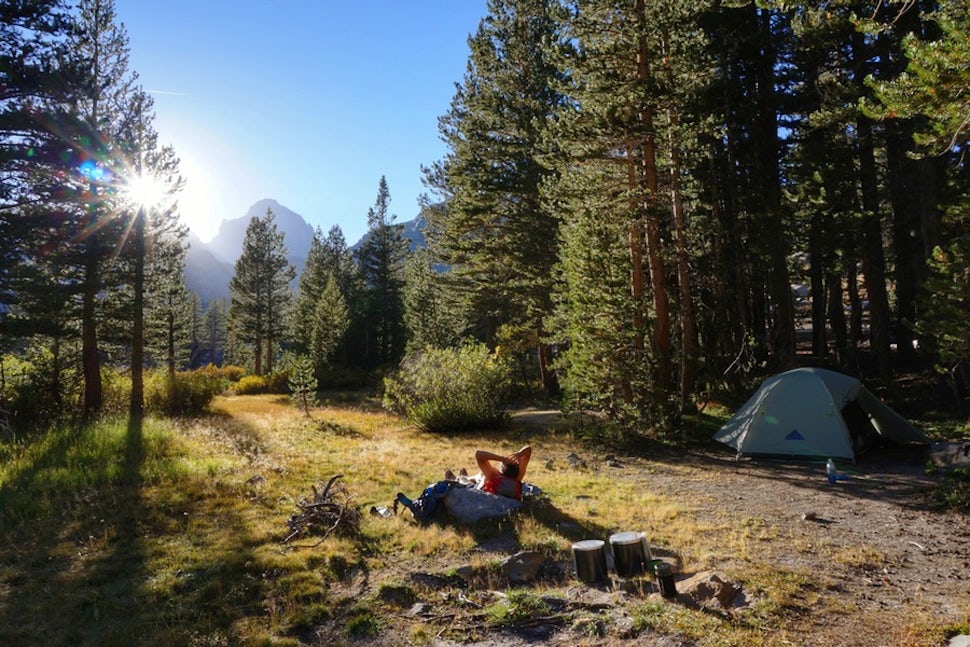The Top 10 Campsites On The John Muir Trail

Most people take about three weeks to hike the 220 John Muir Trail. That means 20+ nights of epic camping. In my 8 Step Guide To Planning Your JMT Hike, I explain that while you can’t really map out where you are going to camp each and every night, there are a few places you aren’t going to want to miss. Here’s a list of some of the best spots to camp along the John Muir Trail that you’ll want to have on your radar as you plan you itinerary.
1. Lower Cathedral Lake (mile 17)
Photo: Kristen Bor
This Yosemite lake is awesome for a few reasons. First, get quintessential views of needle sharp Cathedral Peak which on a calm day forms a perfect reflection in the lake. Then, if you walk out to the west end of the lake, you can watch the sunset over Tenaya Lake in the Valley below. *Note: Lower Cathedral Lake is located about 1/2 mile off of the John Muir Trail and requires a short side trail. Learn more.
2. Thousand Island Lake (mile 43)
Photo: Kristen Bor
There is a reason this lake was one of Ansel Adam’s favorite places to photograph. Banner and Ritter Peaks rising in the distance, amazing swimming, and dozens of tree-covered islands dotting the lake make it one of the more recognizable lakes in the Sierras. Learn more.
3. Lake Ediza Junction (mile 47)
Photo: Kristen Bor
Once you’re out there you’ll start to see that afternoon sun is a critical component of an awesome campsite. A few sites around the Lake Ediza junction offer just that. Beyond Lake Ediza, you descend down to Shadow Lake, which is gorgeous, but shady as the name implies. So stop here and bask in those rays until the sun sets behind the jagged ridge to the west. While the creek will likely be too shallow to swim in, photographers will love the morning reflection of the mountains in the creek. Learn more.
4. Virginia Lake (mile 72)
Photo: Kristen Bor
We didn’t stay here because we thought it was too early to stop for the day, so we had a nice long lunch, did some swimming, and continued on. As we left the lake, a deep sense of regret started to sink in, and we agreed that we should've camped here. On the west side of the lake, there are dozens of flat and private spots to set up shop that provide easy lake access and beautiful views. Learn more.
5. Bear Creek (mile 96)
Photo: Kristen Bor
You stumble on Bear Creek after a long hot, dusty hike up and over Bear Ridge, and when you finally reach Bear Creek's idyllic swimming holes, you’ll be dying for a place to cool off. So take a dip and relax the rest of the day on the big flat granite boulders that are scattered throughout the middle of the cascades. Learn more.
6. McClure Meadow (mile 119)
Photo: Kristen Bor
The night we spent in McClure Meadow happened to be a full moon, and watching the moonrise above Evolution Basin was one of the most spectacular things I’ve seen in my life. There is also a lovely meandering creek where you can watch the sunset and soak your sore feet. Learn more.
7. Lakes North of Pinchot Pass (mid 159)
Photo: Kristen Bor
Unlike other areas on the trail, the mountains around Pinchot Pass are dominated by neon red hues that light up during the alpenglow hour. There are several isolated lakes to choose from, so have your pick and enjoy those gorgeous colors. Learn more.
8. Middle Rae Lake (mile 172)
Photo: Kristen Bor
Middle Rae Lake will likely be one of the busier campsites you encounter on the trail, but it’s for a reason. Awesome swimming, iconic peaks like Fin Dome and the Painted Lady, and some of the most perfect sunrise reflections make it worth putting up with a small crowd. Learn more.
9. Bighorn Plateau (mile 196)
Photo: Kristen Bor
Bighorn Plateau offers unparalleled views of the night sky, and it’s also where you get your first glimpse of Mt. Whitney. Being on a flat expanse completely above the treeline, Bighorn Plateau is a great place to practice some night photography. However, you should only camp on the plateau if the sky is clear. Getting caught up there in a thunderstorm is not only unpleasant but can be very dangerous. Learn more.
10. Above Guitar Lake (mile 206)
Photo: Kristen Bor
Everything I read leading up to my hike was that Guitar Lake was the last place to get water before heading up to Mt. Whitney. As a result, that’s where most people spend their last night on the trail. Just before Guitar Lake, we ran into a ranger who told us that if we kept going about a 1/2 mile above Guitar Lake there were a series of small unnamed lakes, so we decided to check it out. It ended up being the best decision. Guitar Lake gets cold and shady early in the afternoon, but the small lake above it offered solitude, late day sun, and an incredible view of the sun setting behind Guitar Lake. We couldn't have ask for a better way to spend our last night on the John Muir Trail. Learn more.
Follow Kristen's adventures on the JMT and beyond:
Bearfoot Theory | Facebook | Twitter | Instagram | Pinterest
We want to acknowledge and thank the past, present, and future generations of all Native Nations and Indigenous Peoples whose ancestral lands we travel, explore, and play on. Always practice Leave No Trace ethics on your adventures and follow local regulations. Please explore responsibly!
Do you love the outdoors?
Yep, us too. That's why we send you the best local adventures, stories, and expert advice, right to your inbox.


















